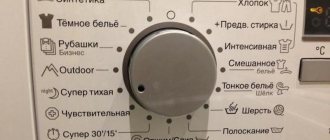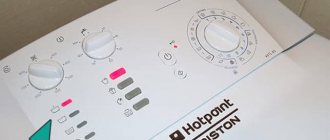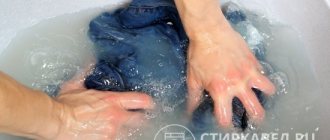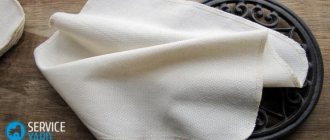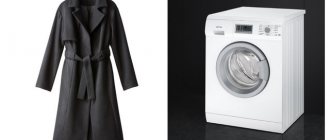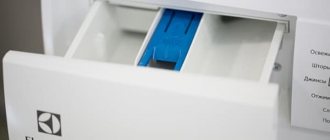It has long been believed that the hotter the water, the better the wash. However, today experts say that it is not at all necessary to heat the water; you can get by with cold water. This is due to the special functions of modern washing units and the composition of new gels and powders. Using the “Cold Wash” mode in a washing machine, you will not only be able to wash your laundry perfectly, but also reduce energy costs, shorten the operating time of the machine, and minimize the risk of damage to the product.
Which water should you choose for washing – cold or hot?
Most housewives do not even think about the question of which water is better to wash in - cool or hot. After all, only hot water can cope with complex contaminants, and the powder will dissolve in it much better and faster than in cold water. However, few realize that cold washing also has its advantages, and for some fabrics such cleaning is the only way to remove contaminants.
In hot water, you should wash first those items that require disinfection. This could be bed linen, kitchen and bath towels, children's clothing or heavily soiled items. In other cases, it is not necessary to heat the water, since modern powders do an excellent job of cleaning in cold water.
Washing without heating water has the following advantages:
- Does not damage the product. Prolonged exposure to hot water is detrimental to fabric. Products made of silk, wool and other delicate materials are especially affected. The structure of the fibers is disrupted, as a result of which the item decreases in size or, conversely, stretches, and barely noticeable holes appear on the surface of the material, which after several washes turn into huge holes. All these troubles can be avoided if you use the “Cold Wash” mode.
- The color of the product is preserved. Cool water does not wash out the paint, so things do not fade and retain their original color for a long time.
- Energy saving. As you know, the main energy consumption of a washing machine occurs during heating of water. When using cold water, a minimal amount of energy is wasted, therefore, the electricity bill will be much lower.
We recommend: How to wash a lambrequin at home so that it does not lose its shape?
In addition, by washing with cool water, the housewife saves her time, and there is no need to worry about the cleanliness of clothes, since modern powders and gels do an excellent job at any temperature.
When can you not do without hot water?
It may seem that experts recommend completely avoiding the use of hot water when washing clothes. This is not true at all.
Sometimes you really can't do without hot water. For example, when you need to get rid of dust mites. Even if you regularly wash your clothes with cold water, occasionally run the wash on a high temperature to get rid of detergent residue and mildew and give your washing machine longer life.
It is also worth paying attention to the tags attached to each item of clothing, which indicate the recommended washing temperature and other information that will be useful when caring for items that have to be washed regularly.
Found a violation? Report content
How many degrees is the water temperature for a cold wash?
Most manufacturers of modern washing units include a “Cold Wash” mode in the machine’s functionality, with which you can guarantee special care for thin and delicate fabrics. The program works as follows: after loading the laundry into the drum and activating the button with the appropriate name, the intake from the water supply system begins, but the heating element does not turn on and the water does not heat up.
Do not confuse the “Quick Wash” and “Cold Wash” modes. The difference between them is that in the first case, the water still heats up, albeit a little, only up to +30 degrees, but the heating element must turn on, and a certain amount of electricity is spent on this.
The water temperature during “Cold Wash” is the same as in the water supply:
- In the summer, it can reach +25°C and even +30°C.
- In winter it drops to +15°C.
- Residents of the private sector use wells or wells in which the water can be almost icy, down to +2°C.
Due to the fact that detergents are almost insoluble in liquids with temperatures below +10°C, it will not be possible to carry out high-quality cleaning in such conditions without heating.
How to wash in plain water without powder when traveling
If you did not take detergents with you on your hike, you will have to wash your clothes simply in water without detergents.
How to wash clothes in clean water:
- for starters, avoid using light-colored clothing, wear dark-colored clothing if you are hiking;
- soak clothes in a bucket of hot water before washing for at least 15 minutes - the hotter the water, the better;
- stand inside the bucket and march in place. at least two minutes, as a bonus you will receive a warm foot bath;
- Now all that remains is to squeeze it out well and let the clothes dry in the sun.
Clothes may not be 100 percent clean after washing, but they are clean enough and, of course, odorless. A little clean is better than nothing.
So we answered the question whether it is possible to wash clothes simply with clean water without detergent.
Cold wash gel and powder
Detergents for cleaning clothes in cold water have special requirements:
- They must combine both traditional detergent enzymes and specific surfactants that can remove dirt under the most unfavorable conditions.
- Powders must be completely dissolved in cool water, otherwise a hard coating will be deposited on the drain pipes, preventing the normal discharge of waste liquid.
We recommend: Wash a huge blanket so that it remains fluffy and soft
We list the detergents that are suitable for “Cold Wash”.
Spark
The product contains natural optical brighteners and enhanced enzymes that penetrate deep into the fibers and remove old stains and other contaminants. Suitable for cleaning white and colored laundry, excluding wool and silk.
Pros and cons of Spark powder
compound
no odor
efficiency
without phosphates
not suitable for wool and silk
How to turn off the heating in the machine?
The programs stored in the memory of the automatic machine involve heating water to a certain temperature. Typically, washing machines have modes of 30°C, 40°C, 60°C, 95°C. All models of washing machines from different manufacturers allow the ability to completely turn off the heating in order to wash in cold water.
So, on LG washing machines, in order to start washing without the participation of a heating element, you need to press the “Temperature” button on the control panel until the indicator lights up opposite the inscription “Cold”. In this case, the heating element will not be activated; the machine will use tap water at the original temperature.
Indesit washing machines have a special temperature switch. If you turn the knob to the “Snowflake” icon and start the wash, the water drawn into the system will not heat up. Bosch washing machines are equipped with a button with the “°C” symbol. You should click on it several times until the indicator opposite the snowflake symbol lights up. Candy machines have a separate button on the panel, by clicking on which you can turn off water heating in any mode.
The instructions for a specific washing machine model describe how to wash in cold water.
If the user manual has been lost for a long time, the necessary information can be found on the Internet. To do this, you should create a search query with the full name of the machine, for example, “Samsung WF8590NLW8DYLP instructions.” This is how you will find the “booklet” for the machine in electronic form.
How to wash blankets and pillows
Blankets and pillows made from synthetic and other fibers can be washed in the washing machine if the load allows. Wash, as a rule, at 60 degrees on a long cycle to wash all the corners and seams. Tennis balls that can be used in the dryer will come to the rescue with this.
Duvets and pillows have a specific smell after washing. During washing, fluff and feathers get lost and the product becomes dense.
After drying, the smell disappears, and the lumps are easily broken up by hand. An automatic dryer copes better with this problem.
How to wash cotton items
This fabric is used to sew:
- Shirts;
- Blouses;
- Trousers;
- Mikey
and other.
After sorting by color:
- Remove individual stains before washing;
- Turn inside out before washing;
- Wash at the temperature recommended by the manufacturer, usually no higher than 40 degrees;
- White cotton tends to turn yellow, so do not wash with products containing chlorine; only those containing oxygen bleach;
- It is better not to dry T-shirts in the sun or in a dryer, as this shortens the life of the fabric;
- With print, iron inside out.
Wash polyester with size reduction
At what temperature should I wash a T-shirt that has an artificial composition? It is quite easy to shrink synthetics; to do this you need:
- Set the washing machine to the permissible temperature and select the medium spin mode. This is enough to carry out the procedure.
- If you don’t have a washing machine, a container of water with a temperature of no more than 30 degrees will come to the rescue. In order for the item to shrink after washing, it must be kept under these conditions for about 15 minutes.
Well-wrung out wardrobe items are hung on hot radiators or hung out in the fresh air directly in the sun. After complete drying, products made from artificial fibers take on the required dimensions.
How to wash jeans
Denim trousers are present in almost every wardrobe, but few people know that this fabric does not like washing. Shortens the life of the item.
Individual stains on jeans should be removed regularly.
When you feel that your pants have become rough, put them in the freezer for a few days: the cold will kill bacteria, neutralize odors and make your pants look clean again.
This practice cannot be continued indefinitely. Therefore, sooner or later you will have to wash:
- Turn inside out;
- Fasten the zipper and buttons;
- Set the washing machine to low temperature.
How to prepare clothes for washing
Inspect each item carefully. If you find stains, treat them before washing. Soak the item in water and remove the stain with powder or laundry soap. Particularly difficult stains can be treated with a stain remover.
Check your pockets - they should be empty. Fasten all buttons, zippers and snaps. This way the item will not be deformed, and hooks and fasteners will not tear other clothes during washing.
It is better to turn jeans, clothes with embroidery, prints and other decorative elements inside out. Delicate items with lace and rhinestones, as well as bras with underwire, are best placed in a special laundry bag. It will protect clothes from damage, and the machine from possible small parts getting into the mechanism.
At what temperature should I wash?
Universal temperature standards that ensure the safety of fabrics during washing:
- 90 degrees – towels, pajamas, children’s bodysuits;
- 60 degrees - tablecloths, bed linen, children's clothing;
- 40 degrees - shirts, cotton underwear, dresses, denim materials, sweatshirts, trousers, T-shirts, cotton blouses;
- 30 degrees - lace, silk and wool.
It is necessary to take into account the type of fabric fibers, the degree of contamination, and the presence of stains.
The range of fabrics is amazing. New ones are appearing. Therefore, you need to know how to wash things in a washing machine. In the end, it makes life easier.
The washing machine washes with cold water: reasons
The heating element is responsible for heating the water entering the machine. This is a tubular heater that is found in every laundry appliance. The unit is connected to the cold water supply network. It takes some time to heat up to the desired temperature: depending on the power of the machine and the selected program, from 5 to 20 minutes. Therefore, if you touch the hatch and it does not heat up at least a little, perhaps the required time for heating has not yet passed. If the washing machine runs its normal cycle, the washing temperature is set to more than 30 degrees, and the hatch remains at the same temperature, then most likely the heating element has failed. It often forms scale and a layer of “dirt” from small fluff from clothes being washed, impurities in the water, and powder residues. As a result, it stops heating and heating the water. The problem is easily solved - the heating element can be replaced. This does not affect the operation of the machine in any way; after replacement, it will last for many more years. This is one of the most common problems with washing machines.
There are other reasons why a washing machine washes with cold water:
- The temperature sensor is broken. It determines how hot the liquid is in the machine and, in accordance with this, sends commands to the control unit. When it breaks, it does not recognize that the water is cold and does not give the command to heat it. If the temperature sensor is acting up, it can be replaced.
- Problems with the electronic control unit. The board elements or the tracks between them, responsible for heating, may burn out. In this case, you can replace individual parts, solder faulty tracks, or install a new control unit.
- Damage to wiring or contacts. They oxidize or wear out from prolonged use or excessive vibration if installed incorrectly. In private homes, rodents may be a problem. The wiring is changed or repaired: contacts are soldered, wires are twisted.


